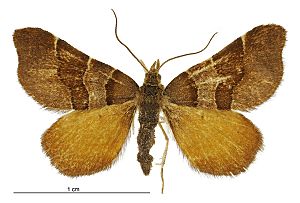Cephalissa facts for kids
Quick facts for kids Cephalissa |
|
|---|---|
 |
|
| Male | |
| Conservation status | |
 Nationally Vulnerable (NZ TCS) |
|
| Scientific classification | |
| Kingdom: | |
| Phylum: | |
| Class: | |
| Order: | |
| Family: | |
| Subfamily: |
Larentiinae
|
| Genus: |
Cephalissa
Meyrick, 1883
|
| Species: |
C. siria
|
| Binomial name | |
| Cephalissa siria Meyrick, 1883
|
|
| Synonyms | |
|
|
The Cephalissa moth is a unique type of moth because it's a monotypic genus. This means it's a group of moths with only one known species, called Cephalissa siria. You might also hear it called the orange triangle moth because of its bright colors.
This special moth is endemic to New Zealand, which means it's found naturally only there and nowhere else in the world. Sadly, the Department of Conservation has listed this species as nationally vulnerable. This means it needs protection because its numbers are low and it's at risk of disappearing.
Contents
Discovering the Orange Triangle Moth
How it Got its Name
The Cephalissa moth and its species, Cephalissa siria, were first officially described in 1883. A scientist named Edward Meyrick gave it its name. He used specimens, which are examples of the moth, that were collected by Frederick Hutton in Dunedin, New Zealand.
Later, in 1898, another scientist named George Vernon Hudson also described and drew pictures of this moth. He called it Hydriomena siria at the time. He used this same name again in his book from 1928.
Where to Find Old Specimens
A very important example of this moth, called a lectotype specimen, is kept safe at the Natural History Museum, London. This specimen helps scientists confirm what the species looks like.
What the Orange Triangle Moth Looks Like
The orange triangle moth is a medium-sized moth, usually about 16 to 18 millimeters (about 0.6 to 0.7 inches) long. Its front wings are a reddish-brown color. They have darker patterns, including a narrow curved band near the base. There's also a wider band in the middle of the wing. These bands are sometimes outlined with a yellowish-white color.
The hindwings, or back wings, are a bright, deep orange color. They might have a reddish-brown tint near the edges. The edges of the hindwings are a bit uneven, with a slight bump in the middle.
Where the Orange Triangle Moth Lives
Its Home in New Zealand
This moth is only found in New Zealand. When it was first discovered, it was seen in Dunedin. Later, it was also found near Invercargill in a place called Waihopai Scenic Reserve. In 1939, it was noted that the moth lived in the Waianiwa and Takitimo mountains in the Southland area.
Changes in Its Range
Unfortunately, the orange triangle moth's home range has shrunk over time. It's no longer seen in Dunedin or Invercargill. However, you can still find it in eastern Otago and in the Rongahere Gorge, which is along the Clutha River.
The northernmost place where this moth has been found is the Dansey Ecological District. It has also been spotted at the Mt Watkin Scenic Reserve, which is north of Dunedin.
Where the Moth Likes to Live
The orange triangle moth prefers certain types of places to live. Scientists have seen it in kahikatea forests, especially among Carex plants, which are a type of grass-like plant. It also lives in short tussock grasslands and areas with shrubs in the Dansey Ecological District.
Moth Life Cycle
When Adults Are Active
Adult orange triangle moths can be seen flying around during the months of October and November. This is when they are active and looking for mates.
What the Larvae Eat
The young moths, called larvae or caterpillars, have a specific plant they like to eat. Their main food source is a plant called Fuchsia perscandens. This plant is very important for the survival of the moth's young.
Protecting the Orange Triangle Moth
This moth is classified under the New Zealand Threat Classification System. It is listed as nationally vulnerable. This means that while it's not yet critically endangered, its population is small and it faces threats. Efforts are being made to protect its habitats and help its numbers grow.

